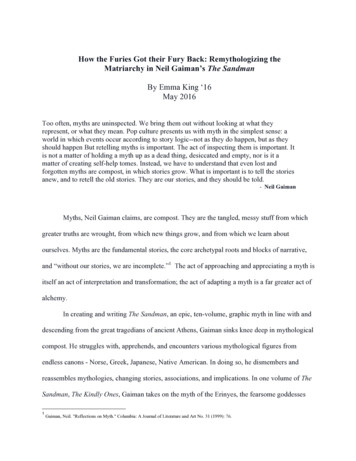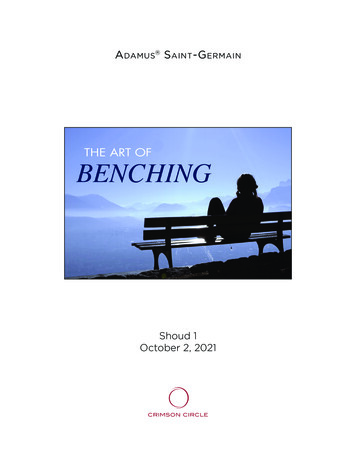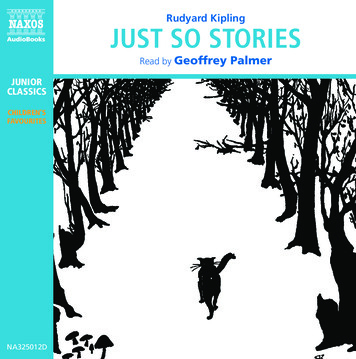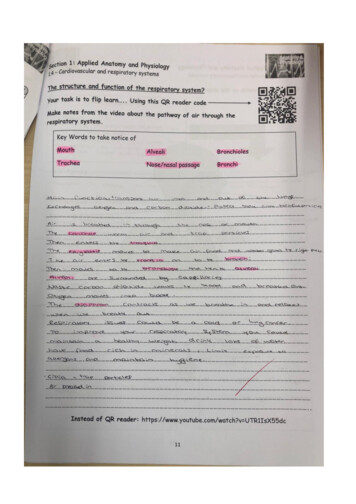
Transcription
How the Furies Got their Fury Back: Remythologizing theMatriarchy in Neil Gaiman’s The SandmanBy Emma King ‘16May 2016Too often, myths are uninspected. We bring them out without looking at what theyrepresent, or what they mean. Pop culture presents us with myth in the simplest sense: aworld in which events occur according to story logic--not as they do happen, but as theyshould happen But retelling myths is important. The act of inspecting them is important. Itis not a matter of holding a myth up as a dead thing, desiccated and empty, nor is it amatter of creating self-help tomes. Instead, we have to understand that even lost andforgotten myths are compost, in which stories grow. What is important is to tell the storiesanew, and to retell the old stories. They are our stories, and they should be told.- Neil GaimanMyths, Neil Gaiman claims, are compost. They are the tangled, messy stuff from whichgreater truths are wrought, from which new things grow, and from which we learn aboutourselves. Myths are the fundamental stories, the core archetypal roots and blocks of narrative,and “without our stories, we are incomplete.”1 The act of approaching and appreciating a myth isitself an act of interpretation and transformation; the act of adapting a myth is a far greater act ofalchemy.In creating and writing The Sandman, an epic, ten-volume, graphic myth in line with anddescending from the great tragedians of ancient Athens, Gaiman sinks knee deep in mythologicalcompost. He struggles with, apprehends, and encounters various mythological figures fromendless canons - Norse, Greek, Japanese, Native American. In doing so, he dismembers andreassembles mythologies, changing stories, associations, and implications. In one volume of TheSandman, The Kindly Ones, Gaiman takes on the myth of the Erinyes, the fearsome goddesses1Gaiman, Neil. "Reflections on Myth." Columbia: A Journal of Literature and Art No. 31 (1999): 76.
best known from the Aeschylean play with which the volume shares a name, Eumenides (usuallytranslated as “the kindly ones”). Gaiman’s interaction with the myth dramatically alters thegender dynamics, ideologies, and implications associated with the Furies by some scholars.Froma Zeitlin and Jeanne Schroeder, for example, purport that Aeschylus’ Furies represents aparadigmatic political and social subjugation of femininity to a patriarchal regime. If examinedthrough the lenses provided by these writers, it becomes clear that the way in which Gaiman digsthrough the compost of the myth of the Erinyes results in a reversal of this subjugation. Byexpanding the figure of the Furies to represent an all encompassing feminine force that governsthe "waking” rather than the "dreaming” world and embodies unrivaled strength, Gaimantransforms the Aeschylean myth into one where the Furies are not suppressed and subordinated tothe patriarchy, but rather destroy the masculine paradigm and in its place effect a cosmicunification of male and female.An Epic in Ten VolumesNeil Gaiman’s The Sandman is an epic tragedy, a graphic novel with an unusually highnumber of words - sometimes, lacking space, the words crawl around the edges of the pages. Itspans ten distinct volumes, shifting focus and pictorial style; each volume has a plot that is bothindependently coherent and relies on previous stories. Its protagonist, Dream, also calledMorpheus, is one of the Seven Endless beings: Destiny, Death, Dream, Destruction, Desire,Despair, and Delirium. The Endless are the physical incarnations of these concepts, each rulingover their own realm, interacting with life across all known and unknown worlds. They areimmortal, but transcend gods. Gods, in Gaiman’s world, are born dreams and rely on the worshipand faith of believers to sustain them. The Endless do not rely on belief to exist. They simply are.2
The Sandman unfolds throughout a complex and non-linear plot, following Dream andthose impacted by him. In simplest terms, over ten volumes, Dream is captured, escapes, andregains lost amulets, fights various foes, rules over his realm, the Dreaming and, in thepenultimate volume, dies. This volume, The Kindly Ones, is the focus of this essay.The story follows a woman named Hippolyta Hall, once a super-heroine called The Fury,and her son Daniel, conceived while she was an unwitting captive in the Dreaming. One day,Daniel is kidnapped. Lyta, distraught, blames Morpheus, who had claimed that he would come forDaniel, “the child [she] carried so long in dreams.”2 Wavering on the border of sanity anddelusion, believing that her son is dead, Lyta wanders through strange, half-real worlds, seekingout her ancestors, the Furies, to exact vengeance upon the Dream King. The Furies initially refuseher plea, as Morpheus did not kill or kidnap Daniel. However, they gleefully pursue him foranother devastating crime; he had killed his own son. This action - not the loss of Lyta’s son - isenough to justify to the Furies their relentless pursuit of his destruction. They shred the Dreaming,destroying everything and everyone in their wake, and Dream surrenders, walking hand in handwith his sister Death to his own. Satisfied, the Kindly Ones depart. Simultaneously, Daniel (oncefound) transforms into the next, more human incarnation of Dream.The Sandman as MythGaiman himself is preoccupied with myth, mythmaking, and gods. His works often focuson the evolution of divinities, and on their relative significance in a given situation. Consequently,many authors have approached his work by examining its mythological components. StephenRauch’s work, Neil Gaiman’s The Sandman and Joseph Campbell: In Search For the ModernMyth, encounters Gaiman’s work as a manifestation of mythological material. Rauch2Gaiman, Neil. The Kindly Ones. (New York, USA: DC Comics, 1996): ch. 3, p 23.3
acknowledges that in The Sandman Gaiman is not just an interpreter of myth, but rather rewritesit, creating new myths and new steps in the evolution of the myth.Using Campbell’s paradigms, Rauch outlines the use of classical mythological plotlinesand archetypes within The Sandman that support the transformation and continuation of mythwithin the work.3 Campbell, Rauch explains, describes mythology as "the secret opening throughwhich the inexhaustible energies of the cosmos pour into human cultural manifestation." Throughhis preoccupation with myth, classical mythological form, and storytelling, Gaiman claimsAeschylus, Euripides, Hesiod, and Homer as storytelling ancestors, casting himself as amythmaker, a member of the echelon of artists whose role it is to translate Campbell’s“inexhaustible energies of the cosmos” into appreciable language.4 This argument is corroboratedby Timothy Evans, who states that “Gaiman's goal.is the pursuit of human universals throughintertextuality.”5 Indeed, Gaiman states that The Sandman attempts to create a new mythology, amodern mythology that encompasses the power of ancient and modern symbolism.6 In short, thestrength and substance of The Sandman as mythological material enables the reader to encounterit as a mythology, and to view it as another in a long line of dramatic revisions and schismaticadditions to the mythological canon.Whence Came ErinyesThe myth of the Erinyes, also called the Furies, possesses a long and complicated history.The Erinyes are Chthonic goddesses of righteous vengeance - invoked or provoked when sacredbinds or oaths are desecrated. They have ancient roots and are part of the group of divinitieschronologically older than the more familiar Olympians. Chthonic deities are associated with the345Rauch, Stephen. Neil Gaiman's The Sandman and Joseph Campbell: In Search of the Modern Myth. (Holicong, PA: Wildside Press, 2003), 1-15.Rauch, Neil Gaiman's The Sandman and Joseph Campbell, 20-24.Evans, Timothy H. "Folklore, Intertextuality, and the Folkloresque in the Works of Neil Gaiman." The Folkloresque: Reframing Folklore in aPopular Culture World. Ed. Michael Dylan Foster. (Logan, UT: Utah State UP, 2016). 67.6Gaiman. "Reflections on Myth,” 78.4
earth (χθόνιος, literally “subterranean”), femininity (as the earth, personified by Gaia, is feminine)and typically have been described as being born during or prior to the ageof the Titans.7 The Erinyes are given different pedigrees at different times. In his Theogony,Hesiod describes them as the daughters of Gaia, born when the blood of the castrated Ouranos hitGaia, the Earth (making them contemporaries with Aphrodite) (Hes. Th., 176-185). Aeschylusand Vergil deem them daughters of Νύχ, Night, while the Orphic Hymns tell us that Persephoneand Hades are their parents, linking them to a feminine deity and to the underworld.8The outline of their myth is consistent: the Erinyes are goddesses (varying in number frommany to three, a number made authoritative by Vergil in his Aeneid)9 who are depicted in theunderworld as gaolers and purifiers of the damned dead,10 and on earth as goddesses called uponto exact vengeance or to avenge a desecration of a sacred bond.11 They are often seen in thecontext of familial betrayal, perhaps when a parent has been wronged by their child,12 but mostfamously, when a mother is wronged by her son.13 Victims of the Erinyes are assaulted bymadness, pursued by the goddesses to the point of insanity and eventually, death.14 The mostfamous of these myths is the one found in Aeschylus, where Clytemnestra’s death by her son,Orestes (committed as an act of revenge for the slaughter of his father), wakens the Furies.15However, the Furies are also associated with Demeter, a powerful goddess associated notonly with the earth, but with femininity. This version of the myth guides us towards the complexand compound system of gendered dynamics associated with the Erinyes. The Erinyes, revenge,789Hesiod, and Richmond Lattimore, Trans. The Works and Days. Theogony. The Shield of Herakles.( Ann Arbor: U Mich Press, 1959): 176-185.Taylor, Thomas. Hymns and Initiations. (Frome: Prometheus Trust, 2003). Hymns 29, 70.Virgil, and Robert Fagles. The Aeneid. (New York: Viking, 2006)101112131415Plato, and R. D. Archer-Hind. Trans. The Phaedo of Plato. (New York: Arno Press, 1973): 107d.Taylor, Thomas. Hymns and Initiations. (Frome: Prometheus Trust, 2003). Hymns 69-70.Homer, and Robert Fagles, Trans. The Iliad. (New York, NY, U.S.A.: Viking, 1990): XV.200-5Aeschylus,and Peter Meineck, Trans. Oresteia. (Indianapolis, IN: Hackett Pub., 1998).Brown, A. L. "The Erinyes in the Oresteia: Real Life, the Supernatural, the Stage." Journal of Hellenic Studies 103 (1983). 14.Aeschylus, Eumenides.5
and death are here all linked to womanhood, particularly fertility, but also to the earth, to thewaking, walking, Chthonic world.16Gaiman’s version of the myth deliberately utilizes the Erinyes’ associations withfemininity and savage justice. Aeschylus’ account of the Erinyes also takes advantage of theseassociations, but to specific ends. According to Zeitlin and Schroeder, Aeschylus uses the myth toestablish a strong antagonistic dichotomy between the Olympian and the Chthonic as well asbetween the dichotomies Symbolic/Real and Masculine/Feminine.17 The story is a culmination ofthe Oresteia, a trilogy recounting of the downfall and absolution of the house of Atreus. Oresteshas murdered his mother for killing his father, Agamemnon (in retribution for Agamemnon’s ownsacrifice of their daughter).18 The death of his mother at his hands sets the Erinyes after him,intent to drive him to complete dissolution and death. Apollo intervenes, demanding that Orestesbe put on fair trial in Athens. The jury is tied and Athena casts the final lot for innocence. Sheexplicitly sides with men, saying “I was born of no mother, and I defer to the male, in all thingswith all my heart” (Aesch. Eum. 736), prioritizing the apparent justice of the matricide over thewrong done by betraying a sacred familial bond. The Erinyes are enraged and feel cheated,demanding his death at their hands. Athena ameliorates the situation by giving the Furies a newdomain in Athens, under the new epithet, the Eumenides: “the Kindly Ones.” Aeschylus’ Erinyesbegin as wretched, blood thirsty creatures, who simultaneously indicate and stimulate madness inOrestes; they transform into tamed women.1916Johnston, Sarah Iles. "Purging the Polis: Erinyes, Eumenides, and Semnai Theai." Restless Dead: Encounters between the Living and the Deadin Ancient Greece. (Berkeley: U of California, 1999): 270-280.17Zeitlin, Froma I. "The Dynamics of Misogyny: Myth and Mythmaking in Aeschylus' Oresteia," in Playing the Other: Gender and Society inClassical Greek Literature.( Chicago: U of Chicago, 1996); Schroeder, Jeanne Lorraine. "The Eumenides’ Return: The Founding of Law Throughthe Repression of the Feminine." in The Triumph of Venus: The Erotics of the Market. (Berkeley: U of California), 27818Aeschylus, Oresteia19Brown. "The Erinyes in the Oresteia," 30.6
Mythic MatriarchsAeschylus’ Eumenides has endured, its mythological status and ideological implicationsworming their way into Gaiman’s modern retelling of the myth. Froma Zeitlin in particularexamines the dynamics, metaphors, and progression of events within Aeschylus’ Oresteia interms of gendered ideology and society.20 Aeschylus’ trilogy, she claims, demonstrates socialevolution as a movement from “matriarchy” (represented by the ancient, regressive, and primitiveErinyes) to “patriarchy” (associated with Orestes and his patron, Apollo).21 Orestes establishes theprioritization of the male over the female by excising his mother from his creation and placing theresponsibility entirely in the hands of his father. The two crimes of the Oresteia - matricide andmurder of a husband - are then compared by Athena, who proclaims them unequal because of herbelief that men and fathers are more important and noble than women and mothers, therebyabsolving Orestes.22 His absolution is revealed as a political maneuver when one considers thatthe Aeschylean Erinyes represent the terrifying, primordial female principle, “championing ajustice that is blind, archaic, barbaric, and regressive, a justice that is to be superseded by the newinstitution of the law court.”23 The female principle is transformed, rendered inert, and involvedas a supporting role in the new system of law, gender ideology, and justice. The Erinyes representthe allegedly overthrown and primitive female principle of power, and their fury with Orestes andApollo is in the name of this denigration of female power.24This ideology is manifested throughout Eumenides. The first description of the Furiesdescribes them as2021222324Zeitlin."The Dynamics of Misogyny."Zeitlin."The Dynamics of Misogyny," 100Zeitlin."The Dynamics of Misogyny," 100Zeitlin."The Dynamics of Misogyny," 101For similar reading, see Norman O. Brown’s 1953 introduction to Hesiod’s Theogony.7
[A] throng of women.No, not women, they were a hideous sight,/more like Gorgons, butworse, much worse.the creatures in there have no wings, they are dark, dank anddisgusting./Their foul stench and hideous breath forced me back,/and their eyes seep arepulsive, putrid pus./They are wrapped in black dismal rags not fit for human sight.(Eum. 45-50)They are fearsome, grotesque creatures that bear malevolence and horror, diametrically opposedto and inherently lesser than Olympian gods, the masculine sphere, and patriarchal symbolism.25The link between their malevolence and matriarchal womanhood is emphasized in thisdescription. For Aeschylus, the Erinyes are “wholly identified with the primordial negativefemale principle.”26 This fearful Chthonic power is metamorphosed by Athena, who renamesthem in an action that, in light of Zeitlin’s arguments, represents a deliberate subjugation of thefeminine. That is to say, the Furies only become ‘Kindly’ after acquiescing to the male sphere.Jeanne Schroeder explores this taming, arguing that the legal system that absolves Orestesis only masculine, and the Erinyes are wholly outside of this paradigm. She then explains that thefeminine Erinyes are associated with tangible experience and with cold truth, stating thatonly the masculine is completely circumscribed by the law. The feminine always escapes.Indeed the rule of law is a masculine fantasy erected to veil or hide the truth of femininefreedom the Furies are the real that existed before the creation of the symbolic law. TheFuries are the denial of all masculine claims to power.”27Furthermore, she views the creation of the masculine and the feminine as debasements of eachother; the creation of a traditional gendered binary relies on the undermining of the opposinggender.28 Given that the symbolic law and legal systems are masculine, they are also inherentlymisogynistic and disempowering to the feminine/real sphere and its representatives: the feminineand matriarchal Furies.25262728Zeitlin."The Dynamics of Misogyny," 111Zeitlin."The Dynamics of Misogyny," 101Schroeder. “The Eumenides’ Return," 285Schroeder. “The Eumenides’ Return," 309.8
The patriarchal reformation of the furious and unsatisfied Furies makes them a part ofunreality and of symbolic law. Apollo and Athena subsume them into a masculine and rationalworld (just as she herself has been subsumed into a logical world - giving herself a father whenbefore she had none, and forsaking a mother), endowing them with the power to protect Athensand dole out justice as the Eumenides.29 The Furies have no place in the symbolic, masculineworld initially, and pursue Orestes not because of symbolic law, but because of a violation of themost basic, primal sort: the slaughter of his mother, and the breaking of a familial, matriarchaloath.30 They are pursuing a truth, a non-symbolic reality.The Trifold GoddessGaiman takes the basic framework allotted by Aeschylus and reverses the ideologicaleffects. As in Aeschylus, the Erinyes are goddesses, fiercely feminine, and willing to dispensejustice of the most primal variety, but they are not subservient to any patriarchal regime.Critically, alliances of the patriarchal with the symbolic and the matriarchal with the real, and theensuing antagonistic dichotomy between male and female, is reaffirmed time and again in TheKindly Ones. In short, the dichotomy between symbols and non-symbolic reality is perpetuated inanalogy through the dichotomy between dreams and waking.It is important to understand that the Erinyes in Gaiman’s work are just a single aspect ofthe trifold goddess, a character that appears throughout myth and throughout The Sandman indifferent guises. In rendering them this way, he complicates the figure of the Erinyessignificantly. His Furies are not only Erinyes (their number taken from Vergil and Orphic hymns),but also the fates, and the tri-fold goddess in all her incarnations of the Crone, the Mother, theMaiden (sometimes corresponding to Hecate, Demeter, and Persephone, and other times to2930Schroeder. “The Eumenides’ Return,." 302Schroeder. “The Eumenides’ Return," 2789
Hecate Demeter and Diana, and so on). The tri-fold goddess encompasses all divine femaletrinities and, while always drawn as a maiden, a mother, and an ancient woman, their portrayalchanges to depict whichever aspect is in focus (fig. 1). As the Erinyes, the tri-fold goddess isdepicted as merciless, with battle armor, scorpions, blood, and weapons (fig. 2), distinguishingher from Aeschylus’ Furies, who were depicted as hook nosed, short haired, gruesome, semiwomen as the Erinyes, and femininely graceful divinities as the Eumenides (fig. 3).31 Byassociating the Erinyes with a theoretically endless number of female divinities - includingChthonic figures - and delineating them as battle-ready, Gaiman presents them as clear andempowered representatives of femininity, matriarchy, and Chthonic power.Dream, the protagonist of the entire series, is the King of Dreams, the acting monarch ofthe most symbolic realm. He is also unequivocally masculine, given male epithets (King, Lord),depicted with harsh, angular lines, lacking any feminine curves, and seeks out feminine loverswho praise his masculinity, as seen in figure 4. He is also, crucially, the father of Orpheus inGaiman’s retelling. Traditionally, Orpheus is the son of Apollo, the very same representative ofthe patriarchal and symbolic field in Eumenides, and the de facto enemy of the Erinyes. Thisidentification of Morpheus, Lord of Dreams, and Apollo only serves to reinforce the associationbetween Dream and symbolism/patriarchy, as well as the polarization between Dream and theKindly Ones. Emphasizing the parallels further, it is because of the filicide of that same son,shared mythologically with Apollo, that the Furies ultimately prosecute Dream.The Dreaming, the world of Dreams over which Morpheus rules, is a perfect manifestationof symbols. Dreams are the creations of minds, never literal, representative instead of fears,hopes, ideas; they are the worlds that will never be, books never written, journeys contemplated31Maxwell-Stuart, P. G. "The Appearance of Aeschylus' Erinyes." Greece & Rome Greece and Rome 20.01 (1973): 81-84.10
and not yet taken taken. It is also “somewhat of a boy’s club,”32 both generally lacking andinhospitable to significant female characters. The only major characters living in the Dreamingthat are not explicitly identified as male or patriarchal are Eve, the first woman, born of Adam’srib, who lives on the very border of the Dreaming, and Nuala, a fairy servant given to Morpheusas a gift. Women, in the world of Dreams, are liminal creatures, not quite present, andconsistently without a voice.Outside the Dreaming, however, women are consistently associated with tangibleexperience and with wakefulness. Lyta Hall, even as she searches through what seems to be aDream-like realm for the Kindly Ones, is nevertheless bound to the waking world. Her story isdepicted twice and side-by-side, first from her perspective, then from an objective viewer’s (figs.5, 6). In her eyes, as we see on the top frame of figure 5 and the right side of figure 6, she wandersthrough a lush world, encountering various Chthonic triads from the Gorgons to the three-headedshe-snake that betrayed Eve. Simultaneously, the reader is shown that Lyta is wandering throughthe dull, grey streets of a city, growing increasingly ragged, speaking to snakes, to cats, tohomeless women and to herself, in a storefront window (fig. 6). The more time she spendssearching, the more she resembles traditional representations of the Furies. Figure 7 depictsLyta’s transformation into a Chthonic body: snakes writhe in her hair, her face becomes gaunt andsinisterly shadowed, her hands, clawed, she yearns aloud for vengeance.33 Finally, Lyta findsherself confronted by her own reflection, clean-cut, beautiful, in the guise of the Fury, hersuperheroine alter-ego and a one-time member of the Justice League. Lyta, covering her eyes,bedraggled and be-clawed, is told by her alter-ego that3233Gaiman, The Kindly Ones, ch. 4, p 22Maxwell-Stuart, P. G. "The Appearance of Aeschylus' Erinyes.” 81-84.11
Of course I’m not crazy. I’m one of the good guys. I am the Fury. My feet are plantedfirmly on the ground. This is probably some super-villain’s mind-control rayexperiment.Resist, Lyta! Resist! (fig. 8).Even in her search for the Furies, supernatural creatures of Vengeance, she binds herself towaking, to groundedness, to sanity and to non-symbolic reality.The connection between women and waking is shown not only symbolically in Lyta’sjourney, but is also stated by three women in a nursing home. These women are the mouthpiecesof the Erinyes, and are depicted in figure 9 with shapes and shadows mirroring those inked for theFuries. Discussing the hostile dichotomy between men and women, they tell a young girl thatWomen are about waking. As mothers, we wake them from nothingness to existence. Asmaidens we wake them to the joy and misery of adulthood, wake them to the worlds oflust and responsibility. And then, when their time is up, it’s always us has to wash themfor the last time, and lay them out for the wake (fig. 8).34This statement is followed by a invective that “Acts of revenge are sanctified,” a statement thatserve to reinforce the connection between women, waking, and revenge.35The Kindly Ones are the natural antonym to Dream; they are to reality and Chthonism asDream is to symbology and Olypianism. However, unlike in Aeschylus’ myth, the Kindly Onesturn not on the female representative of masculinity, but on the embodiment of the masculineparadigm himself. Incentivized to attack by Lyta, the Kindly Ones pursue not only Dream, but allthat he represents, structures, and rules; they systematically destroy the Dreaming, shaking itsvery core (fig. 10). In a clear inversion of the movements made by Aeschylus in Eumenides, thereis no trial for the accused, no system of justice laid out to quell bloodthirsty and primal femininejustice, no female divinity compelled to rule in favor of Morpheus, in favor of an intangibleparadigm. The only adjudication that holds weight is that of the Furies, who explicitly do not care3435Gaiman. The Kindly Ones, ch. 6, p. 16Gaiman. The Kindly Ones, ch. 6, p. 1912
about theoretical moral systems, explaining that “worse than beginnings, morals. I’ve got no timefor them. No time at all” (fig. 16).36Their strength, self-awareness, and unstoppable agency manifest repeatedly - from theirpreferred appellation to the rhetoric they voice. During her deranged, mournful supplication to theErinyes, Lyta mistakenly refers to them as Furies (her own super-heroic pseudonym). She iscontradicted, told “not the Furies. That’s such a nasty name. It’s one of the things they [men] callwomen to put them in their place” (fig. 14).37 Instead, the Erinyes wish to be called the KindlyOnes, a term which seems ludicrous. They are not kindly, and they are not the Goddesses tamedby Athena’s decision to envelop them in acceptable and patriarchal womanhood. Nevertheless,they wish to be called the Kindly Ones, and their power is so recognized that all beingsacquiesce.38 In placing the decision to refer to the Erinyes as Kindly Ones in the hands of theErinyes themselves, Gaiman takes them out of the domain of patriarchal influence, and undertheir own sovereignty. Furthermore, he reverses associations made with Furies and Kindly Ones;Lyta, called the Fury, is part of the Justice League, a system of symbolic law - as Aeschylus’Eumenides are made to be, while the amoral Kindly Ones pay no heed to any such system. Theyare in control of themselves and everything they do; Morpheus himself acknowledges this, knowsthat “the ladies have power to avenge blood crimes.the ladies are renowned for theirrelentlessness.”39 He knows that he can stop neither them nor their victory.The three women and Lyta move swiftly through the Dreaming, slaughtering the dreamsthey encounter, reaping them, laying waste to the entire realm. The art in this section is unique.36373839Gaiman, The Kindly Ones, ch. 13, p. 24Gaiman, The Kindly Ones, ch. 7, p. 21.Gaiman, The Kindly Ones, ch. 10, p. 16.Gaiman, The Kindly Ones, ch. 11, p. 7.13
The reader is not a bystander, watching the Furies kill symbols from afar. Instead, as depicted infigure 11, the massacre is drawn in the first-person, through the eyes of the Kindly Ones. Everydeath at their hands is also at ours. We see the fear in the eyes of each character, the resignation,the panic. We see what could be our own shadows, truly the shadows of the Furies, loomingdarkly over every doomed character (fig. 12), or we stare at Morpheus as he tries to confront theFuries, looking tiny on a crag, with lightning cracking all around him (fig. 14). No longer are theKindly Ones subsumed by the patriarchy; rather, we, the readers, are subsumed into theirencompassing feminine being by Gaiman’s choice to have us see through their perspective.The Kindly Ones are given agency as uncontrollable, imperturbable feminine beings. Wenot only literally see from their perspective along with them, but also, like Morpheus, werecognize and submit to their inimitable will, made more ominous by flashes of lightningsignifying their violent presence and by the sense of omnipotence the first person perspectivelends (fig. 12). Again, we see that the viewer shares a perspective with the looming Eumenides,and Morpheus seems small, perched on the top of a crag, surrounded by the Kindly Ones and bythe strength of their presence (figs. 12, 13, 14). They have already announce themselves asimmune to anything he could do to them, stating that, “We have no nightmares. Gods fear us,Demons fear us. We have hounded kings and angels. We have taken vengeance on worlds and onuniverses. We are the Kindly Ones. We are the Eumenides.”40 He can do nothing; they arestronger than he is. Their task, vengeance for his filicide, is their one priority. As they themselvessay, they “will do what we shall do. Eh, Dreamer? We will do what we must.”41 The completionof their task is inevitable, and they tell Morpheus that fighting against them is pointless. If he triedto fight, “nothing would change, Dream-King. How will you fight us? You cannot even touch us.4041Gaiman, The Kindly Ones, ch. 10, p. 16.Gaiman, The Kindly Ones: Ch. 12, p 18.14
Take your stand. We care not. We will continue to rip apart your world, bit by bit, shred byshred.”42The inherent femininity of Lyta and the Furies gives them power that is both impossibleand unnecessary to repress. Over and over, they are drawn as looming presences, unremitting andunquestionably female, asserting their power over Morpheus and the Dreaming. Gaiman, inmaking the Furies’ power and agency so evident, emphasizes how distinct they are fromAeschylus’. Not only have the Furies destroyed the Dreaming (metaphorically, the patriarchy),but they have also transformed Lyta, whose history as the beautiful and justice-see
Neil Gaiman's The Sandman and Joseph Campbell: In Search of the Modern Myth. (Holicong, PA: Wildside Press, 2003), 1-15. 4 Rauch, Neil Gaiman's The Sandman and Joseph Campbell, 20-24. 5 Evans, Timothy H. "Folklore, Intertextuality, and the Folkloresque in the Works of Neil Gaiman." The Folklo










